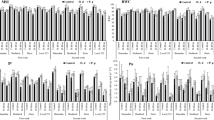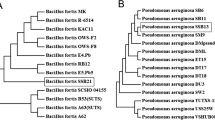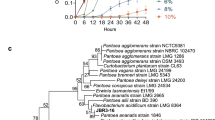Abstract
Salinity adversely affects plant growth and development. Halotolerant plant-growth-promoting rhizobacteria (PGPR) alleviate salt stress and help plants to maintain better growth. In the present study, six PGPR strains were analyzed for their involvement in salt-stress tolerance in Arachis hypogaea. Different growth parameters, electrolyte leakage, water content, biochemical properties, and ion content were analyzed in the PGPR-inoculated plants under 100 mM NaCl. Three bacterial strains, namely, Brachybacterium saurashtrense (JG-06), Brevibacterium casei (JG-08), and Haererohalobacter (JG-11), showed the best growth of A. hypogaea seedlings under salt stress. Plant length, shoot length, root length, shoot dry weight, root dry weight, and total biomass were significantly higher in inoculated plants compared to uninoculated plants. The PGPR-inoculated plants were quite healthy and hydrated, whereas the uninoculated plant leaves were desiccated in the presence of 100 mM NaCl. The percentage water content (PWC) in the shoots and roots was also significantly higher in inoculated plants compared to uninoculated plants. Proline content and soluble sugars were significantly low, whereas amino acids were higher than in uninoculated plants. The MDA content was higher in uninoculated plants than in inoculated plants at 100 mM NaCl. The inoculated plants also had a higher K+/Na+ ratio and higher Ca2+, phosphorus, and nitrogen content. The auxin concentration was higher in both shoot and root explants in the inoculated plants. Therefore, it could be predicted that all these parameters cumulatively improve plant growth under saline conditions in the presence of PGPR. This study shows that PGPR play an important role in inducing salinity tolerance in plants and can be used to grow salt-sensitive crops in saline areas.

Similar content being viewed by others
References
AOAC (1995) Official methods of analysis of AOAC international. In: Cunniff P (ed) Agricultural chemicals, contaminants, drugs, 16th edn, vol 1. AOAC, Arlington, VA
Agarwal PK, Jha B (2010) Transcription factors in plants and ABA dependent and independent abiotic stress signaling. Biol Plant 54:201–212
Ali SZ, Sandhya V, Grover M, Kishore N, Rao LV, Venkateswarlu B (2009) Pseudomonas sp. strain AKM-P6 enhances tolerance of sorghum seedlings to elevated temperatures. Biol Fertil Soils 46:45–55
Al-Maskri A, Al-Kharusi L, Al-Miqbali H (2010) Effects of salinity stress on growth of lettuce (Lactuca sativa) under closed-recycle nutrient film technique. Int J Agric Biol 12:377–380
Andreae WA, Ysselstein MWHV (1956) Studies on 3-indoleacetic acid metabolism. III. The uptake of 3-indoleacetic acid metabolism by pea epicotyls and its conversion to 3-indolacetylaspartic acid. Plant Physiol 31:235–240
Andreae WA, Ysselstein MWHV (1959) Studies on 3-indoleacetic acid metabolism. V. Effect of calcium ion on 3-indoleacetic acid uptake and metabolism by pea roots. Plant Physiol 35:220–224
Ashraf M (1994) Organic substances responsible for salt tolerance in Eruca sativa. Biol Plant 36:255–259
Ashraf M, Akram NA (2009) Improving salinity tolerance of plants through conventional breeding and genetic engineering, An analytical comparison. Biotech Adv 27:744–752
Ashraf M, Fatima H (1995) Responses of some salt tolerant and salt sensitive lines of safflower (Carthamus tinctorius L.). Acta Physiol Plant 17:61–71
Ashraf M, Foolad MR (2007) Roles of glycine betaine and proline in improving plant abiotic stress resistance. Environ Exp Bot 59:206–216
Ashraf M, Harris PJ (2004) Potential biochemical indicators of salinity tolerance in plants. Plant Sci 166:3–16
Ashraf M, Tufail M (1995) Variation in salinity tolerance in sunflower (Helianthus annuus L.). J Agron Soil Sci 174:351–362
Bano A, Fatima M (2009) Salt tolerance in Zea mays (L). following inoculation with Rhizobium and Pseudomonas. Biol Fert Soils 45:405–413
Bates LS, Waldern R, Teare ID (1973) Rapid determination of free proline for water stress studies. Plant Soil 39:205–207
Bloemberg GV, Lugtenberg BJJ (2001) Molecular basis of plant growth promotion and biocontrol by rhizobacteria. Curr Opin Plant Biol 4:343–350
Boyer JS (1982) Plant productivity and environment. Science 218:443–448
Bradford M (1976) A rapid and sensitive method for the quantitation of microgram quantities of protein utilizing the principle ofprotein-dye binding. Anal Biochem 72:248–258
Chakraborty U, Chakraborty B, Basnet M (2006) Plant growth promotion and induction of resistance in Camellia sinensis by Bacillus megaterium. J Basic Microb 46:186–195
Chen K, Kurgan L, Rahbari M (2007) Prediction of protein crystallization using collocation of amino acid pairs. Biochem Biophys Res Commun 355:764–769
Chinnusamy V, Jagendorf A, Zhu J (2005) Understanding and improving salt tolerance in plants. Crop Sci 45:437–448
Cram WJ (1976) Negative feedback regulation of transport in cells. The maintenance of turgor, volume and nutrient supply. In: Luttge U, Pitman MG (eds) Encyclopaedia of plant physiology, new series, vol 2. Springer-Verlag, Berlin, pp 284–316
Dimkpa C, Weinand T, Asch F (2009) Plant–rhizobacteria interactions alleviate abiotic stress conditions. Plant Cell Environ 32:1682–1694
Fougere F, Le-Rudulier D, Streeter JG (1991) Effects of salt stress on amino acid, organic acid, and carbohydrate composition of roots, bacteroids and cytosol of alfalfa (Medicago sativa L.). Plant Physiol 96:1228–1236
Gaxiola RA, Rao R, Sherman A, Grisafi P, Alper SL, Fink GR (1999) The Arabidopsis thaliana proton transporters, AtNhx1 and Avp1, can function in cation detoxification in yeast. Proc Natl Acad Sci USA 96:1480–1485
Gilbert GA, GAdush MV, Wilson C, Madore MA (1998) Amino acid accumulation in sink and source tissues of Coleus blumei Benth. during salinity stress. J Exp Bot 49:107–114
Giri B, Kapoor R, Mukerji KG (2007) Improved tolerance of Acacia nilotica to salt stress by arbuscular mycorrhiza, Glomus fasciculatum, may be partly related to elevated K+/Na+ ratios in root and shoot tissues. Microb Ecol 54:753–760
Gontia I (2010) Isolation and characterisation of halotolerant plant growth promoting rhizobacteria from Salicornia brachiata, PhD thesis, Bhavnagar University
Gontia I, Kavita K, Schmid M, Hartmann A, Jha B (2011) Brachybacterium saurashtrense sp. nov., a halotolerant root-associated bacterium with plant growth promoting potential. Int J Syst Evol Microbiol. doi:10.1099/ijs.0.023176-0
Gossett DR, Millhollon EP, Lucas MC, Banks SW, Marney MM (1994) The effects of NaCl on antioxidant enzyme activities in callus tissue of salt-tolerant and salt-sensitive cultivars (Gossypium hirsutum L.). Plant Cell Rep 13:498–503
Gyaneshwar P, Naresh Kumar G, Parekh LJ, Poole PS (2002) Role of soil microorganisms in improving P nutrition of plants. Plant Soil 245:83–93
Hamdia MA, Shaddad MAK, Doaa MM (2004) Mechanism of salt tolerance and interactive effect of Azospirillum bransilense inoculation on maize cultivars grown under salt stress conditions. Plant Growth Regul 44:165–174
Han HS, Lee KD (2005) Physiological responses of soybean inoculation of Bradyrhizobium japonicum with PGPR in saline soil conditions. Res J Agric Biol Sci 1:216–221
Hodges DM, DeLong JM, Forney CF, Prange RK (1999) Improving the thiobarbituric acid‐reactive‐substances assay for estimating lipid peroxidation in plant tissues containing anthocyanin and other interfering compounds. Planta 207:604–611
Hurkman WJ, Rao HP, Tanaka CK (1991) Germin-like polypeptides increase in barley roots during salt stress. Plant Physiol 97:366–374
Irigoyen JJ, Emerich DW, Sánchez-Díaz M (1992) Water stress induced changes in concentrations of proline and total soluble sugars in nodulated alfalfa (Medicago sativa) plants. Physiol Plant 84:67–72
Jain M, Mathur G, Koul S, Sarin NB (2001) Ameliorative effects of proline on salt stress-induced lipid peroxidation in cell line of groundnut (Arachis hypgaea L.). Plant Cell Rep 20:463–468
Jha B, Gontia I, Hartmann A (2011)The roots of the halophyte Salicornia brachiata are a source of new halotolerant diazotrophic bacteria with plant growth promoting potential. Plant Soil. doi:10.1007/s11104-011-0877-9
Kandasamy S, Loganathan K, Muthuraj R, Duraisamy S, Seetharaman S, Thiruvengadam R, Ponnusamy B, Ramasamy S (2009) Understanding the molecular basis of plant growth promotional effect of Pseudomonas fluorescences on rice through protein profiling. Proteome Sci 7:47
Kloepper JW, Leong J, Teintze M, Schroth MN (1980) Enhanced plant growth by siderophores produced by plant growth promoting rhizobacteria. Nature 286:885–888
Kloepper JW, Zablotowicz RM, Tipping EM, Lifshitz R (1991) In: Keister KL, Cregan PB (eds), The rhizosphere and plant growth. Kluwer, Dordrecht, pp 315–326
Kloepper JW, Rodriguez-Kabana R, Zehnder GW, Murphy J, Sikora E, Fernandez C (1999) Plant root-bacterial interactions in biological control of soilborne diseases and potential extension to systemic and foliar diseases. Aust J Plant Pathol 28:27–33
Kohler J, Hernández JA, Caravaca F, Roldán A (2009) Induction of antioxidant enzymes is involved in the greater effectiveness of a PGPR versus AM fungi with respect to increasing the tolerance of lettuce to severe salt stress. Environ Exp Bot 65:245–252
Kucey RMN, Janzen HH, Leggett ME (1989) Microbially mediated increases in plant-available phosphorus. Adv Agron 42:199–228
Kumar KR, Ashrit RG, Deshpande NR, Hansen JW (2004) Climate impacts on Indian agriculture. Int J Climatol 24:1375–1393
Leidi EO, Silberbush MS, Soares MIM, Lips SH (1992) Salinity and nitrogen nutrition studies on peanut and cotton plant. J Plant Nutr 15:591–604
Leigh RA, Ahmad N, Wyn Jones RG (1981) Assessment of glycine betaine and proline compartmentation by analysis isolated beet vacuoles. Planta 153:34–41
Lugtenberg B, Kamilova F (2009) Plant-growth-promoting rhizobacteria. Annu Rev Microbiol 63:541–556
Lutts S, Kinet JM, Bouharmont J (1996) NaCl-induced senescence in leaves of rice (Oryza sativa L.) cultivars differing in salinity resistance. Ann Bot 78:389–398
Mansour MMF (2000) Nitrogen containing compounds and adaptation of plants to salinity stress. Biol Plant 43:491–500
Mayak S, Tirosh T, Glick BR (2004) Plant growth-promoting bacteria confer resistance in tomato plants to salt stress. Plant Physiol Biochem 42:565–572
Murashige T, Skoog F (1962) A revised medium for rapid growth and bioassay with tobacco tissue cultures. Physiol Plant 15:473–497
Nadeem SM, Zahir ZA, Naveed M, Arshad M, Shahzad SM (2006) Variation in growth and ion uptake of maize due to inoculation with plant growth promoting rhizobacteria under salt stress. Soil Environ 25:78–84
Patten CL, Glick BR (2002) Role of Pseudomonas putida indoleacetic acid in the development of the host plant root system. Appl Environ Microb 68:3795–3801
Rajkumar M, Lee KJ, Lee WH, Banu JR (2005) Growth of Brassica juncea under chromium stress: influence of siderophores and indole 3 acetic acid producing rhizosphere bacteria. J Env Biol 26:693–699
Richardson AE, Barea JM, McNeill AM, Combaret CP (2009) Acquisition of phosphorous nitrogen in the rhizosphere and plant growth promotion by microorganism. Plant Soil 321:305–339
Sandhya V, Ali SZ, Grover M, Reddy G, Venkateswarlu B (2010) Effect of plant growth promoting Pseudomonas spp. on compatible solutes, antioxidant status and plant growth of maize under drought stress. Plant Growth Regul 62:21–30
Saravankumar D, Samiyappan R (2007) ACC-deaminase from Pseudomonas fluorescens mediated saline resistance in groundnut (Arachis hypogaea) plants. J Appl Microbiol 102:1283–1292
Szabolcs I (1994) Salt affected soils as an ecosystems for halophytes. In: Squires VR, Malcom AT (eds) Halophytes as a resource for livestock and for rehabilitation of degraded lands. Kluwer Academic Publishers, Dordrecht, The Netherlands, pp 19–24
Wu SS (2009) Enhanced phytoremediation of salt-impacted soils using plant growth-promoting rhizobacteria (PGPR), PhD thesis, University of Waterloo
Yang J, Kloepper JW, Ryu CM (2010) Rhizosphere bacteria help plants tolerate abiotic stress. Trends Plant Sci 14:1–4
Yildirim E, Taylor AG, Spittler TD (2006) Ameliorative effects of biological treatments on growth of squash plants under salt stress. Sci Hortic 111:1–6
Zahir AZ, Ghani U, Naveed M, Nadeem SM, Asghar HN (2009) Comparative effectiveness of Pseudomonas and Serratia sp. containing ACC-deaminase for improving growth and yield of wheat (Triticum aestivum L.) under salt-stressed conditions. Arch Microbiol 191:415–424
Zhang HX, Blumwald E (2001) Transgenic salt-tolerant tomato plants accumulate salt in foliage but not in fruit. Nat Biotechnol 19:765–768
Zhang H, Xie X, Kim MS, Kornyeyev DA, Holaday S, Pare PW (2008a) Soil bacteria augment Arabidopsis photosynthesis by decreasing glucose sensing and abscisic acid levels in planta. Plant J 56:264–273
Zhang H, Kim MS, Sun Y, Dowd SE, Shi H, Pare PW (2008b) Soil bacteria confer plant salt tolerance by tissue-specific regulation of the sodium transporter HKT1. Mol Plant Microbe Interact 21:737–744
Zhu J (2002) Salt and drought stress signal transduction in plants. Annu Rev Plant Biol 53:247–273
Acknowledgment
The authors are thankful to CSIR, New Delhi (NWP-020), for financial assistance and support.
Author information
Authors and Affiliations
Corresponding authors
Rights and permissions
About this article
Cite this article
Shukla, P.S., Agarwal, P.K. & Jha, B. Improved Salinity Tolerance of Arachis hypogaea (L.) by the Interaction of Halotolerant Plant-Growth-Promoting Rhizobacteria. J Plant Growth Regul 31, 195–206 (2012). https://doi.org/10.1007/s00344-011-9231-y
Received:
Accepted:
Published:
Issue Date:
DOI: https://doi.org/10.1007/s00344-011-9231-y




